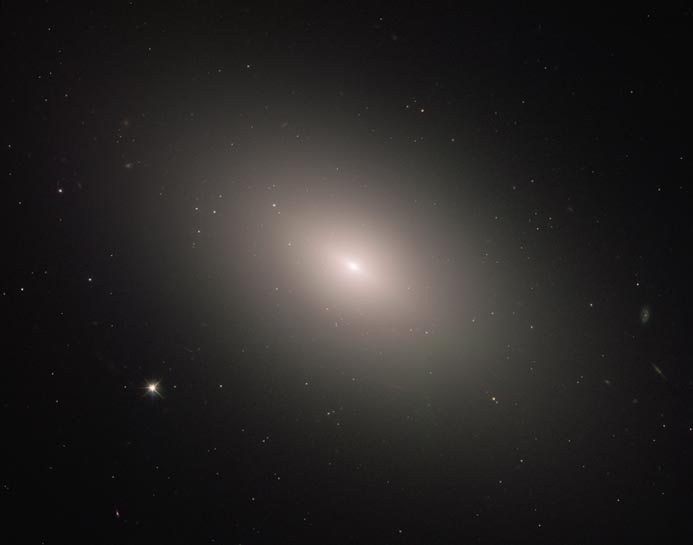
Elliptical Galaxy
RA 12h 42m 2.17s Dec 11° 38' 47.46"
Virgo
50 million light years
10.6
5.4 × 3.7 arcmin
3.13 x 2.50 arcminutes
North is 105.8° right of vertical
ESA/Hubble & NASA, P. Cote
May 27, 2019
ABOUT THIS IMAGE:
This luminous orb is the galaxy NGC 4621, better known as Messier 59. As this latter moniker indicates, the galaxy was listed in the famous catalogue of deep-sky objects compiled by French comet-hunter Charles Messier in 1779. However, German astronomer Johann Gottfried Koehler is credited with discovering the galaxy on April 11, 1779 just days before Messier added it to his collection.
Modern observations show that Messier 59 is an elliptical galaxy, one of the three main kinds of galaxies along with spirals and irregulars. Ellipticals tend to be the most evolved of the trio, full of old, red stars and exhibiting little or no new star formation. Messier 59, however, bucks this trend somewhat; the galaxy does show signs of star formation, with some newborn stars residing within a disc near the core.
Located in the 2000-strong Virgo Cluster of galaxies within the constellation of Virgo (The Virgin), Messier 59 lies approximately 50 million light-years away from us. This image was taken by the NASA/ESA Hubble Space Telescope’s Advanced Camera for Surveys.
From Wikipedia:
Messier 59 or M59, also known as NGC 4621, is an elliptical galaxy in the equatorial constellation of Virgo. M59 is a member of the Virgo Cluster, with the nearest component being separated from M59 by 8? and around 5 magnitudes fainter. The nearest cluster member of comparable brightness is the lenticular galaxy NGC 4638, which is around 17? away. Messier 59 and the nearby elliptical galaxy Messier 60 were both discovered by Johann Gottfried Koehler on Aprili 1779 during observations of a comet in the same part of the sky. Charles Messier listed both in the Messier Catalogue about three days after Koehler's discovery.
This is an elliptical galaxy of type E5 with a position angle of 163.3°, indicating the overall shape shows a flattening of 50%. However, isophotes for this galaxy deviate from a perfect ellipticity, showing pointed shapes instead. These can be decomposed mathematically into a three component model, with each part having a different eccentricity. The main elliptical component appears to be superimposed upon a flatter, disk-like feature, with the entirety embedded within a circular halo. The luminosity contribution of the components is 62% for the pure elliptical part, 22% for the halo, and the remainder coming from the disk. The light ratio of the disk to the main elliptical body is 0.25, whereas it is typically closer to 0.5 in a lenticular galaxy.
The core contains a supermassive black hole (SMBH), with a mass that has been estimated to be 270 million times the mass of the Sun, and counter-rotates with respect of the rest of the galaxy, being bluer.The SMBH is quiescent, but is detectable as an X-ray and radio source that indicates an outflow. The nucleus contains an embedded stellar disk that is bluer (younger) than the bulge region, with a blue component stretching along a position angle of around 150°. This extended disk feature may be the result of a galactic merger followed by a starburst event.
Messier 59 is very rich in globular clusters, with a population of them that has been estimated to be around 2,200. It has a satellite, the Ultra Compact Dwarf galaxy M59-UCD3. One supernova (1939B) has been recorded in M59; it reached a peak magnitude of 11.9. The region where this supernova occurred shows no trace of star formation, which suggests this was a type Ia supernova.